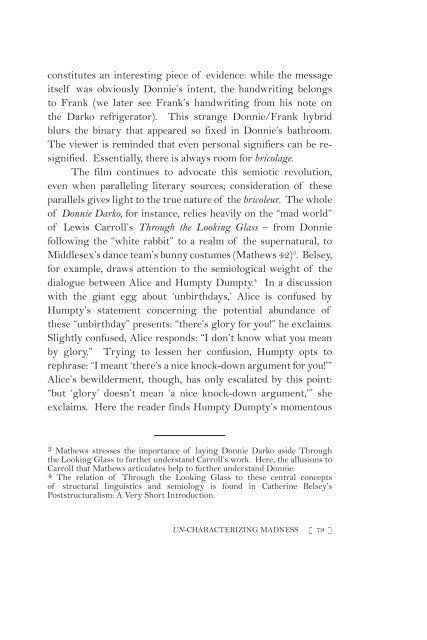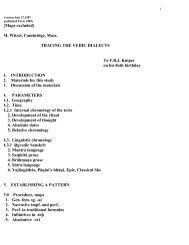Un-Characterizing Madness The Semiotic Revolution of Donnie Darko
Un-Characterizing Madness The Semiotic Revolution of Donnie Darko
Un-Characterizing Madness The Semiotic Revolution of Donnie Darko
Create successful ePaper yourself
Turn your PDF publications into a flip-book with our unique Google optimized e-Paper software.
constitutes an interesting piece <strong>of</strong> evidence: while the message<br />
itself was obviously <strong>Donnie</strong>’s intent, the handwriting belongs<br />
to Frank (we later see Frank’s handwriting from his note on<br />
the <strong>Darko</strong> refrigerator). This strange <strong>Donnie</strong>/Frank hybrid<br />
blurs the binary that appeared so fixed in <strong>Donnie</strong>’s bathroom.<br />
<strong>The</strong> viewer is reminded that even personal signifiers can be resignified.<br />
Essentially, there is always room for bricolage.<br />
<strong>The</strong> film continues to advocate this semiotic revolution,<br />
even when paralleling literary sources; consideration <strong>of</strong> these<br />
parallels gives light to the true nature <strong>of</strong> the bricoleur. <strong>The</strong> whole<br />
<strong>of</strong> <strong>Donnie</strong> <strong>Darko</strong>, for instance, relies heavily on the “mad world”<br />
<strong>of</strong> Lewis Carroll’s Through the Looking Glass – from <strong>Donnie</strong><br />
following the “white rabbit” to a realm <strong>of</strong> the supernatural, to<br />
Middlesex’s dance team’s bunny costumes (Mathews 42) 3 . Belsey,<br />
for example, draws attention to the semiological weight <strong>of</strong> the<br />
dialogue between Alice and Humpty Dumpty. 4 In a discussion<br />
with the giant egg about ‘unbirthdays,’ Alice is confused by<br />
Humpty’s statement concerning the potential abundance <strong>of</strong><br />
these “unbirthday” presents: “there’s glory for you!” he exclaims.<br />
Slightly confused, Alice responds: “I don’t know what you mean<br />
by glory.” Trying to lessen her confusion, Humpty opts to<br />
rephrase: “I meant ‘there’s a nice knock-down argument for you!’”<br />
Alice’s bewilderment, though, has only escalated by this point:<br />
“but ‘glory’ doesn’t mean ‘a nice knock-down argument,’” she<br />
exclaims. Here the reader finds Humpty Dumpty’s momentous<br />
3 Mathews stresses the importance <strong>of</strong> laying <strong>Donnie</strong> <strong>Darko</strong> aside Through<br />
the Looking Glass to further understand Carroll’s work. Here, the allusions to<br />
Carroll that Mathews articulates help to further understand <strong>Donnie</strong>.<br />
4 <strong>The</strong> relation <strong>of</strong> Through the Looking Glass to these central concepts<br />
<strong>of</strong> structural linguistics and semiology is found in Catherine Belsey’s<br />
Poststructuralism: A Very Short Introduction.<br />
UN-CHARACTERIZING MADNESS [ 79 ]
















